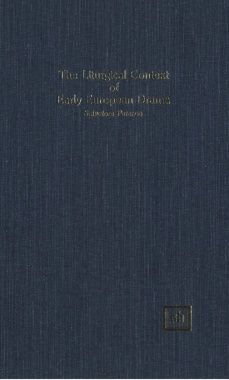"This book can be interestingly and profitably read not only by an academic audience but also by a general public for an understanding and appreciation of two bedrocks, drama and liturgy, a twentieth-century culture." - Lawrence H. Klibbe, New York University. "A chapter on coronation rituals will attract special interest among historians." -Journal of Medieval History.
- Cover
- Table of Contents
- Preface
- Foreword
- Introduction
- Chapter I: CHRISTIAN ATTITUDE IN A PAGAN MILIEU
- A. Patristic Period
- a. Tertullian
- b. Novation
- c. St. Cyprian of Carthage
- d. Lactantius
- e. St. John Chrysostom
- f. Salvian
- g. Ausonius
- h. St. Clement of Alexandria
- i. Appolinaris
- j. St. Athanasius
- k. Prudentius
- l. St. Augustine
- Chapter II: ECCLESISTICAL, RESTRICTIONS AND PROHIBITIONS
- 1. Synod
- 2. Canons of the African Church
- 3. Council of Trullo
- 4. Council of Elvira
- 5. Council of Toledo III
- Chapter III: NOTION OF WORSHIP: FROM TEXT TO PERFORMANCE
- 1. Evidence from the Old Testament
- 2. Evidence from the New Testament
- 3. Evidence from the Christian Community
- Chapter IV: NATURE OF WORSHIP ENTAILS THE SENSE OF THE DRAMATIC
- Evidence of Dramatic Impulse In Early Liturgical Texts
- 1. Pre-Nicene Period
- 2. Post Nicene Period
- 3. Pilgrimage of Egeria
- Chapter V: RECONCILIATION OF PENITENTS
- 1. Church's Position
- 2. Old Testament Basis
- 3. Patristic Period
- 4. Development and Contents of the Rite for Penitents
- 5. Penitential Gestures
- 6. The Rite Itself
- 7. Concluding Remark
- Chapter VI: DEDICATION OF CHURCHES
- 1. Old Testament Sources
- 2. Early Patristic Sources
- 3. Later Christian Sources
- Chapter VII: CORONATION OF RULERS AND OF THOSE IN AUTHORITY
- 1. Early Testimony
- 2. Coronation Rites
- 3. The Sanctuary
- 4. Investing King with Insignia
- 5. Anointing of the King
- 6. Acclamations
- 7. Royal Throne
- 8. Homage
- A. Dramatic Overtones of Biblical Texts
- B. Early Evidence of Anointing
- a. St. Gregory
- b. Julian of Toledo
- c. Charlemagne
- d. Hincmar of Rheims
- e. Louis II
- C. Anglo-Saxon England
- 1. King Edgar
- 2. Egbert's Pontifical
- D. Continental Witnesses
- 1. Aachen
- 2. St. Peter Damian
- 3. Papal Coronations
- Chapter VIII: MONASTIC INFLUENCES
- A. Divine Office
- B. Regularis Concordia
- C. Monastic Constitutions of Lanfranc
- D. St. Hildegard of Bingen
- E. Monastic Displeasure
- Chapter IX: SUNDRY ELEMENTS OF DRAMATIC NATURE IN THE LITURGY
- A. Eastern Testimony
- B. Western Testimony
- C. Hand Clapping
- D. Vatican Council II
- Conclusion
- Bibliography

